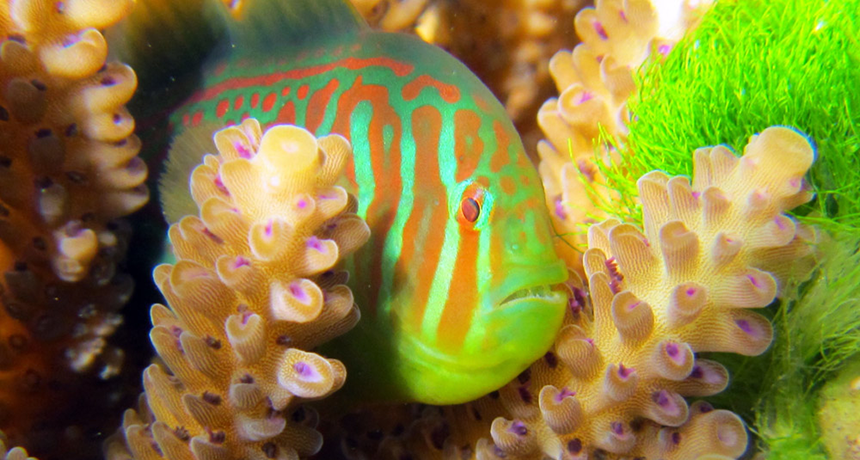Threatened coral get fishy rescue
When toxic seaweed gets too close to this coral, gobies fight and bite back

When toxic seaweed (green at right) gets too close to a type of coral (yellow structure), this fish, a broad-barred goby (Gobiodon histrio), responds to a distress signal sent by the coral and nibbles the seaweed away.
Danielle Dixson
Organisms called coral have hard skeletons that anchor them to the skeletal remains of other, dead coral. These sea creatures, which form stony communities called reefs, are fighting to survive. They’re under attack from overfishing, pollution and climate change. And they have to compete for space and sunlight with seaweed — some of which is poisonous to coral. But new research shows that when threatened by that seaweed, some corals release a chemical that may bring an army of fish to the rescue.
When the seaweed gets too close, the coral emits a chemical that attracts gobies, a type of fish. They nibble back the invaders, protecting the reef’s corals. The finding is a bright spot in an otherwise gloomy field of science that shows many clusters of coral around the world are dying.
“We’ve lost about 80 percent of the living coral in the Caribbean and 50 percent in the western Pacific,” Nancy Knowlton told Science News. “So a better understanding of what keeps corals healthy is essential,” the biologist says. Knowlton, who studies coral as part of her work at the Smithsonian Institution in Washington, D.C., did not work on the new study.
With fewer corals, fish and other creatures living in and near reefs have fewer places to call home. This leads to a decrease in populations of fish — including the gobies that would normally keep invasive seaweed away. That leaves the reef with fewer protectors.
“Without these, you have these algae-covered parking lots,” says study author Mark Hay. A marine ecologist, he works at the Georgia Institute of Technology in Atlanta.
Along with Danielle Dixson, Hay studied a type of coral called Acropora nasuta. It resembles a tight tangle of deer antlers. The researchers put some of the corals into different cages along with some — or none — of the fish that often live in their reefy neighborhood.
Finally, the scientists added the toxic, emerald-green seaweed (Chlorodesmis fastigiata). As it brushes against coral, this seaweed releases a poison that can slay the animal within days.
That seaweed is “really pretty and really nasty,” Hay told Science News. Some types of fish were no help and left at the first sign of danger. But two types of a colorful fish called gobies responded to the coral’s distress call and acted “like little hedge trimmers,” Hay said. Hay and Dixson identified what recruited the gobies: It was a chemical the corals released into the water.
The scientists suggest that the gobies also benefit. Biologists knew that the fish produce a mucus on their skin that acts like a poison to their predators. Hay and Dixson found that when the gobies snacked on the toxic seaweed, they produced a stronger poison, one that acted twice as fast on predators. So when gobies help protect corals, they’re protecting themselves, too.
Scientists don’t understand the chemistry behind the coral-goby partnership. But it does show that biologists have a lot to learn about the complex relationships among animals in a reef.
Power Words
coral Marine animals that produce a hard and stony exoskeleton and live on the exoskeletons of dead corals, called reefs.
goby A small, usually marine fish that often has a sucker on the underside.
ecology The branch of biology that deals with the relationships of organisms to one another and their relationship to their physical surroundings.
seaweed Large algae growing in the sea or on rocks below the high-water mark.







